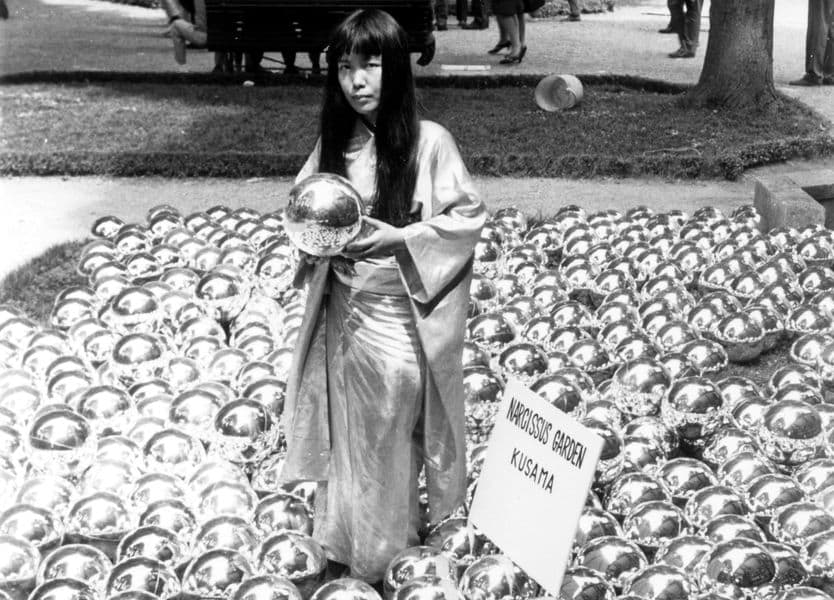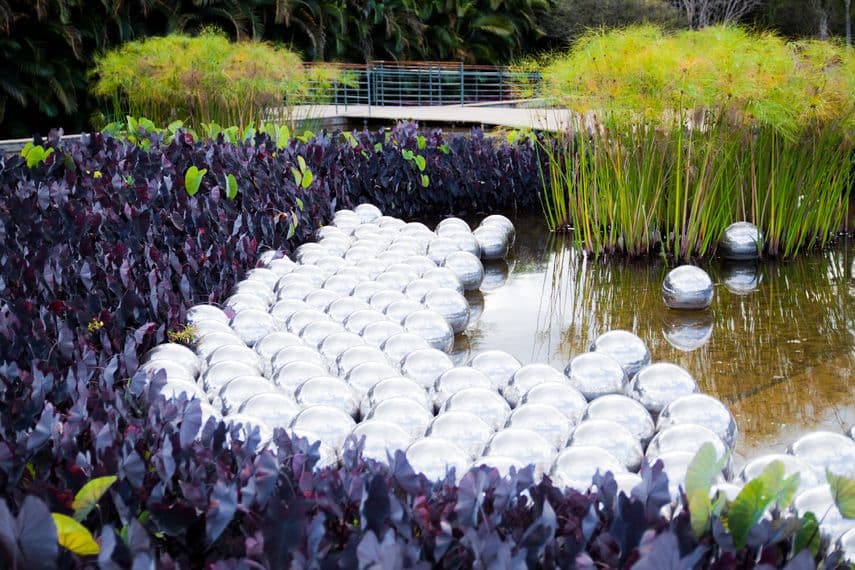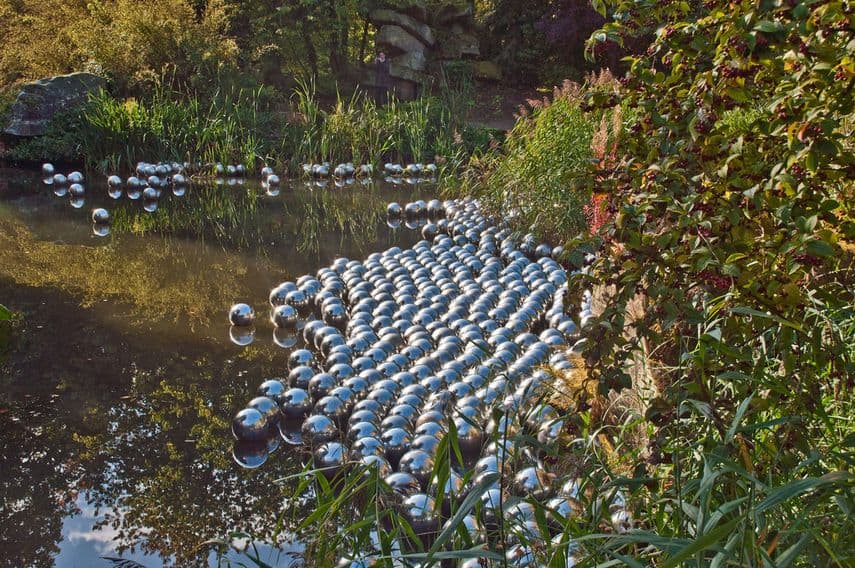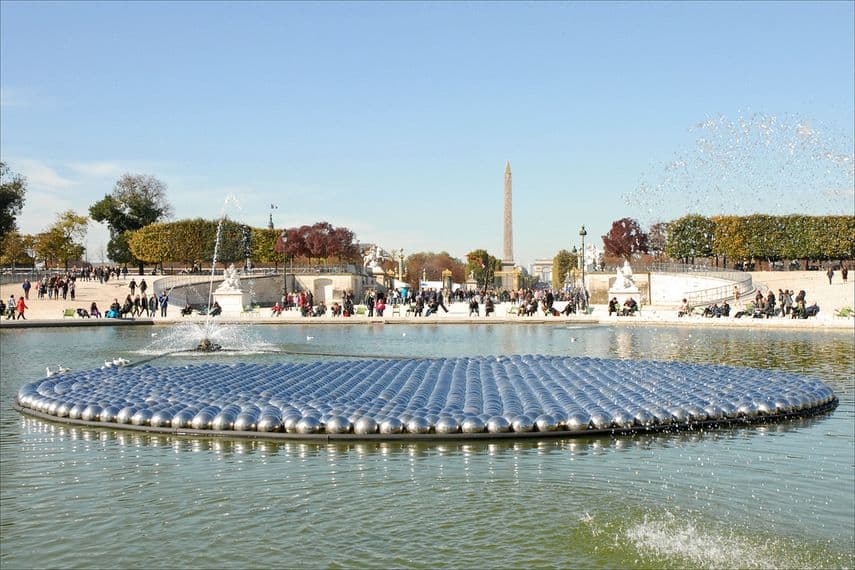[ad_1]
One of the most prominent figures in the Japanese contemporary culture, Yayoi Kusama has developed a practice that shares affiliations with many contemporary movements but resists any singular classification. Struggling with mental illness ever since she was a child, Kusama employed art as a unique survival mechanism, processing her hallucinations, confronting personal phobias and making sense of the world around her.
While her practice spans drawing, painting, collage, sculpture, and performance art, she is best known for her immersive installations. This summer, MoMA PS1 is presenting a site-specific installation of Narcissus Garden.
The installation is presented as the third iteration of Rockaway!, a free public art festival presented with Rockaway Artists Alliance, Jamaica Bay-Rockaway Parks Conservancy, National Park Service, and Bloomberg Philanthropies.

Yayoi Kusama Narcissus Garden at the 1966 Venice Biennale
As art historian Jody Cutler noted, “narcissism is both the subject and the cause of Kusama’s art, or in other words, a conscious artistic element related to content.” The first iteration of Yayoi Kusama‘s Narcissus Garden appeared in 1966 at 33rd Venice Biennale, stirring controversies and immediately attracting public attention.
Although Kusama was not officially invited to exhibit, she received the moral and financial support from Lucio Fontana and permission from the chairman of the Biennale Committee to stage her installation on the lawn outside the Italian Pavilion. Made out of 1,500 mass-produced plastic silver spheres, the installation infinitely reflected the artist who stood among them barefoot and dressed in a gold kimono, but also the visitors, the architecture, and the landscape at the exhibition grounds. Upon picking them up and staring at them, the viewer was forced to confront one’s own vanity and ego.
Standing alongside yard signs inscribed with the words “Narcissus Garden, Kusama” and “Your Narcissism for Sale”, Kusama tossed spheres in the air throughout the opening day of the exhibition, offering them for mere $2 along with flyers with Herbert Read’s complimentary remarks about her work.
While Biennale officials stepped in to put an end to her performance, the installation remained. Launching her to stardom, the first iteration of Narcissus Garden was often interpreted as both Kusama’s self-promotion and her protest of the commercialization of art.

The Life of the Installation After 1966
After the controversial appearance at Venice Biennale, the Narcissus Garden lived on, being featured in a series of performances over the years – which became increasingly more elaborate and often involved multiple participants. After being staged at happenings such as the Body Festival in 1967 in Tompkins Square Park and Washington Square Park, the Love In Festival in 1968, the Bust Out Happening in 1969 in Central Park, and the Grand Orgy to Awaken the Dead in 1968 in the sculpture garden of The Museum of Modern Art, various iterations started to appear all over the world.
Today, these shiny spheres are made of stainless steel and are regarded as valuable commodities for display. Their profound narcissistic undertone is ironically amplified by the notion of viewership in the digital age. Viewers’ reflective images on the convex surfaces are now being snapped with smartphones and immediately shared on various social media. To further accentuate the seduction of one’s one image, Narcissus Garden is often installed on water, referring to the Greek myth about Narcissus who fell in love with his own reflection in the water and eventually drowned.

The Latest New York Installation
Presented by MoMA PS1, the Narcissus Garden is on view in a former train garage from the time when Fort Tilden was an active U.S. military base. The mirrored metal surfaces of 1,500 steel spheres will reflect the industrial surroundings of the now-abandoned building, drawing attention to Fort Tilden’s history as well as the devastating damage inflicted on many buildings in the area by Hurricane Sandy in 2012.
Left in devastation six years ago, the area of the Rockaways continues its fight for rebuilding and resilience. As Klaus Biesenbach, Director of MoMA PS1 and Chief Curator-at-Large at the Museum of Modern Art explained, the installation is part of the continued efforts to “raise awareness of the ongoing restoration work and efforts to ensure the Rockaways are prepared for future effects of climate change.”
[The collaboration with Yayoi Kusama evokes] her youthful, courageous, and adventurous spirit with a work she first exhibited as an emerging artist, like many of the artists who live and work in the Rockaways right now.
Thomas Secunda, Co-Founder of Bloomberg LP and Chair of the Jamaica Bay- Rockaway Parks Conservancy, added that “Narcissus Garden will reflect the beauty of Fort Tilden and draw attention to the industrial history and urban natural environment that makes up Gateway National Recreation Area.”

Narcissus Garden at the Gateway National Recreation Area at Fort Tilden
Presented by MoMA PS1, the installation Narcissus Garden will be on view until at the Gateway National Recreation Area at Fort Tilden, New York until September 3rd, 2018.
It is accompanied by an exhibition in the neighboring Rockaway Artists Alliance Studio 7 Gallery that charts the history of Rockaway! and the ongoing work of the Rockaway Artists Alliance. Following the devastating impact of Hurricane Sandy in 2012, the Rockaway! festival celebrates the ongoing recovery of the Rockaway Peninsula.
Featured image: Gateway National Recreation Area at Fort Tilden, T9 building. Site of Yayoi Kusama’s Narcissus Garden for Rockaway! 2018. Image courtesy MoMA PS1. Photo by Pablo Enriquez. All images courtesy of MoMA PS1.
[ad_2]
Source link
